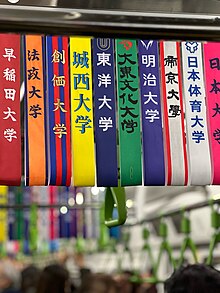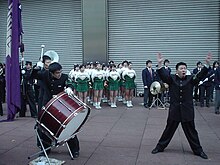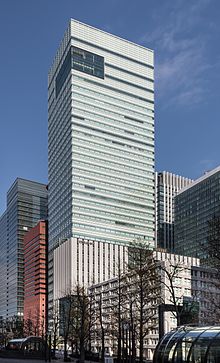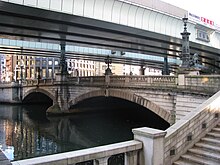Hakone Ekiden (箱根駅伝), officially called the Tokyo-Hakone Round-Trip College Ekiden Race (東京箱根間往復大学駅伝競走, Tōkyō Hakone kan Ōfuku Daigaku Ekiden Kyōsō), is one of the most prominent university ekiden (relay marathon) races of the year held between Tokyo and Hakone in Japan on January 2 and 3. The race is telecast on Nippon Television.
This two-day race from Ōtemachi to Hakone and back is separated into five legs on each day. [1] Due to slight variations in the courses, the first day distance is 107.5 km while the distance on the second day is 109.6 km. [2]
Rules

Five legs are provided between Tokyo and Hakone each way. Each runner runs one section, and alternates with the next runner at a station. Each team has ten runners, who each run with their team's sash which is handed over to the next runner on the team at each station.
If a runner cannot get to a station within a certain time after the leading team reaches it (10 minutes for legs 1–2, 15 minutes for legs 3–4, 20 minutes for all subsequent legs), the next runner starts with a substitute sash. The time difference is added to the goal time.
Participation

Twenty universities, which belong to The Inter-University Athletic Union of Kanto (関東学生陸上競技連盟, Kantō gakusei rikujō kyōgi renmei), can participate in this Ekiden. Ten of them are seeded teams that qualify by virtue of finishing in the top ten the previous year. Ten more teams qualify through their team results at the Hakone Ekiden Yosenkai, a 20 km qualifier held in the October preceding the race. A final select team, the Kanto Region University Student United Team (関東学生連合チーム, Kantō gakusei rengō chiimu), made up of top-placing individuals at October's Yosenkai 20 km Road Race from universities that do not qualify for Hakone as teams. [3] The 2014 and 2024 races did not include a select team, and before 2014, the select team was called the Kanto Region Select Team (関東学連選抜チーム, Kantō gakuren senbatsu chiimu), and were also constituted by a selection of top runners from universities that did not qualify as one of the 20 participating teams.
Seed rights
Teams who finished 10th place or better will be seeded and guarantees participation in the Hakone Ekiden for the next year.
Forfeiture
If a runner retires en route to a station because of an accident, his team is treated as retired. Although runners for following sections may run, their times are not officially recorded.
Course

Day 1, January 2
Leg 1 (21.3 km) From Ōtemachi, Tokyo to Tsurumi, Yokohama

The race begins at 8:00 a.m. in front of the Yomiuri Shimbun Building in Ōtemachi, Tokyo, and follows a relatively flat course along Hibiya-Dori and National Route 15 past various Tokyo landmarks such as Tokyo Imperial Palace, Tokyo Station, Hibiya Park, Zōjō-ji, and Tokyo Tower. Past Shinagawa Station, the runners will encounter some slopes at Shin-Yatsuyamabashi (新八ツ山橋) as well as Rokugōbashi over the Tama River at the 17 km mark, before arriving at the Tsurumi relay station.
This is one of the most important sections because the first runner's rank affects the flow of the entire ekiden for his team. As a result, teams usually enter a strong runner run in this section.
Leg 2 (23.1 km) From Tsurumi to Totsuka
After departing the Tsurumi relay station, the runners reach Yokohama Station before following National Route 1 on their way to Totsuka relay station. As part of the traditional 53 Stations of the Tōkaidō, the runners will face a significant uphill climb at Gontazaka at the 13 km mark. The last 3 km section is also made up of a combination of uphill climbs and downhill descents.
As this is the longest leg of the race, the fastest runner in each team traditionally runs on this course as it has influence on the overall pace of the race. The leg is often referred to as Leg 2 of Flowers (花の2区) in reference to its often star-studded runners and status.
Leg 3 (21.4 km) From Totsuka to Hiratsuka
The first 9 km of leg is marked with a gentle descent as the course gradually departs the urban areas towards the Shōnan coastline. The runners join National Route 134 at Chigasaki, and travel along the coastline with Mount Fuji in front of them and Sagami Bay to their left. Leg 3 finishes after the runners cross the Shonan Bridge over Sagami River, and reaches the Hiratsuka relay station on the coast.
Though considered to be the most scenic leg of the entire race, strong and sometimes unpredictable sea winds force runners to adapt as they exit the urban sections of the race. Like leg 2, leg 3 also often sees placements of the strongest runners of each team in order to keep pace.
Leg 4 (20.9 km) From Hiratsuka to Odawara
The shortest flat section of the race, leg 4 leads runners parallel to the Tokaido Main Line past towns of Ōiso and Ninomiya, before crossing the Sakawa River into the heart of Odawara. Passing by Odawara Castle, the last 3 km stretch of this leg sees a gradual uphill climb, a prelude to leg 5.
From 2006 to 2016, runners ran a shortened leg 4 at 18.5 km, the shortest of all legs, as organizers attempted to create a leg that would better highlight mid-distance runners of each team. However, the 20.9 km length was reinstated for the 2017 edition and has remained in place since.
Leg 5 (20.8 km) From Odawara to Lake Ashi, Hakone

After passing by Hakone-Yumoto Station, the runners run past (or in earlier editions, run through) the Kanreidoumon Gallery to begin their climbs, and pass by various Hakone sights such as the Fujiya Hotel, Hakone Kowakien, a railroad crossing for the Hakone Tozan Line, and Hakone Keimei Gakuen before reaching the highest point of National Route 1 at 16.2 km. Finally, the runners run through the town of Moto-Hakone under the Torii of Hakone Shrine at 19 km, and reach the finish line at Lake Ashi.
Colloquially called The Mountain Climb (山上り) , leg 5 is considered to be one of the most grueling sections of the race that sees runners climb up to 874 m at the highest point of leg. While almost all competitors forego tank tops and opt to dress in long sleeved apparel to combat the low temperatures, leg 5 sometimes sees runners fall to conditions such as hypothermia and hypoglycemia due to its trying nature. This leg often sees uphill specialists from each team being deployed, with many often only running this section for their universities throughout their collegiate career. Those who have consistent high finishes in this section are traditionally referred to as God of the Mountain (山の神).
Day 2, January 3
Leg 6 (20.8 km) From Lake Ashi, Hakone to Odawara
Day 2 of the race begins at 8:00 a.m. with leg 6 being a reverse course of leg 5 from day 1, and its first 4 km section is an uphill section before rapidly descending the mountains, past the same sights as those of leg 5. The teams' coaches are not allowed to join the teams until they have reached Hakone-Yumoto Station at the base of the mountain.
As a reverse of leg 5 and colloquially called The Mountain Descent (山下り) , the downhill leg 6 is a speedy and challenging affair with average runner speeds of 25 km per hour. Runners also need to combat the morning chills of starting early in the morning atop of the mountains, and icy and slippery course conditions are not uncommon dependent on weather conditions. As a combination of these challenging conditions, leg 6 also sees a high number of specialist runners much like leg 5, and those who participate often take tolls on their legs and feet as they reach the bottom of the mountain.
Leg 7 (21.3 km) From Odawara to Hiratsuka
A near-reverse course of leg 4, leg 7 is slightly longer than its parallel during day 1 and sees its runners leave the mountains and head to the coast near Hiratsuka on a mostly flat course with minor inclines after 9 km.
As the sun rises throughout the course of leg 7, the difference of temperature between the start in Odawara and the finish at Hiratsuka is the largest out of all other sections. Runners have to combat and adapt to the changing weather conditions as they move towards Hiratsuka.
Leg 8 (21.4 km) From Hiratsuka to Totsuka
A reverse course of leg 3, the first half of leg 8 is mostly flat, however near Fujisawa there is a significant uphill section near Yugyōji-no-saka (遊行寺の坂) which may causes some runners difficulties.
As the temperatures continue to rise, some runners fall into states of dehydration near Yugyōji-no-saka, and proper management of runners' physical conditions is critical in leading the way to a successful final 2 legs of the race.
Leg 9 (23.1 km) From Totsuka to Tsurumi
A reverse course of leg 2, leg 9 is the longest leg of day 2. After revisiting Gontazaka, now as a downhill section, the rest of the course past Hodogaya Station is a mostly flat affair leading to the Tsurumi relay station.
Like leg 2, Most teams place their second-best runners for this leg, and it is likewise called Leg 9 of Pines (松の9区) to indicate its importance. The leg is critical for leading teams to cement their lead or for trailing teams to close their distance, either in a fight for the championship or a top-10 seeding position to guarantee their return to the next year's race. Owing to the strength of runners in this sections, overtakes are not uncommon during leg 9.
Additionally, the Tsurumi relay station at the end of leg 9 is the most common place for early starts (Kuriage-sutāto (繰り上げスタート)) to occur, as teams need to reach Tsurumi within 20 minutes of the race leaders to prevent a forced early start. Because of the symbolic importance of physically relaying the Tasuki to each teammate throughout the race, emotions often run high when teams fail to do so. The 160 m clear straight section at Tsurumi exacerbates this: teams close to the 20 minute cut-off physically see their teammates near the relay station, but not all teams make the successful exchange at this final relay station.
Leg 10 (23.0 km) From Tsurumi to Otemachi, Tokyo

A near-reverse course of leg 1, and similar to the opening leg, leg 10 is largely flat as runners head towards central Tokyo. The leg follows the same course as leg 1 until the final section, where it deviates east at Babasakimon (馬場先門) in front of the Nijubashi of the Tokyo Imperial Palace before turning north on Chuo-Dori through Kyōbashi. After crossing Nihonbashi, the race returns and concludes in front of the Yomiuri Shimbun Building, where the finish line awaits.
The spectating crowds grow gradually as the race progresses through leg 10, and runners have to face strong winds between tall buildings as they enter more built-up areas of Tokyo. As the final runners of each team close out the race, their teammates awaits them at the finish line in celebration and reflection.
Origin
Hakone Ekiden was started in 1920. [4] Shizo Kanakuri, who is known as the father of the Japanese marathon, conceived the idea. His enthusiastic idea of bringing up a runner who could compete in the world became the driving force of establishing Hakone Ekiden. When Kanaguri was a Tokyo Koto Shihan school (Koshi) student, he participated in Olympic Games in Stockholm in 1912 as one of the representative Japanese marathon runners. He had to give up his race on the way, however. [5]
In the meantime, the first ekiden, Tokaido ekidentohokyoso (東海道駅伝徒歩競走) was held in 1917 between Sanjō Ōhashi, Kyoto and Ueno Shinobazunoike (上野不忍池) Tokyo, celebrating 50 years after Tokyo became the capital. This race was a big relay race between Kyoto and Tokyo (516 km) held by Yomiuri Shimbun for three days. It succeeded and became the original form of Hakone Ekiden. Kanaguri was influenced by the success of the race and persuaded many universities that they should race in the Hakone Ekiden. As a result, Waseda University, Keio University, Meiji University and Tokyo Higher Normal School (now University of Tsukuba) replied to his offer and Hakone Ekiden started. Hakone Ekiden was started with great energy of the pioneers in Japanese sports society. It started during World War I, so industrial areas gradually expanded to the west and the Tokaido road was widened. Reflecting this active atmosphere, the Japanese sports society, including ekiden one, were developing great challenging spirits at that time.
Level of competition in 2010
In the 2010 (86th) race, of the 380 athletes (190 runners and 190 alternates) that represent the 19 universities, 328 have run under 14:40 for 5,000 meters; 150 at 14:20 and 33 under 14:00. [6] This figure compares very strongly with US collegiate men from all schools: athletic.net's list of collegiate men 5000 meters in 2009, which lists approximately 400 athletes at 14:40, 200 at 14:20 and 60 under 14:00 in 2009. Stepping up to the 10,000 meter distance, the same sources show that these 19 Tokyo universities list over 190 runners with personal bests under 30:00 (14 more sub 30 minute runners make up an all-star team of runners from other Tokyo universities); about 90 US collegians ran under 30:00 in 2009.
Winners
Shizo Kanakuri Trophy
This prize is awarded to the most valuable runner. This was founded in 2004(80th) to admire Shizo Kanakuri's accomplishment.
| Year | Iteration | Name | Univ |
|---|---|---|---|
| 2004 | 80 | Yukiharu Kanegae | IUAU Team ( University of Tsukuba) |
| 2005 | 81 | Masato Imai | Juntendo University |
| 2006 | 82 | Masato Imai | Juntendo University |
| 2007 | 83 | Yuki Sato | Tokai University |
| Masato Imai | Juntendo University | ||
| 2008 | 84 | Jun Shinotou | Chuo Gakuin University |
| 2009 | 85 | Ryuji Kashiwabara | Toyo University |
| 2010 | 86 | Ryuji Kashiwabara | Toyo University |
| 2011 | 87 | Akinobu Murasawa | Tokai University |
| 2012 | 88 | Ryuji Kashiwabara | Toyo University |
| 2013 | 89 | Shota Hattori | Nippon Sport Science University |
| 2014 | 90 | Kento Ohtsu | Toyo University |
| 2015 | 91 | Daichi Kamino | Aoyama Gakuin University |
| 2016 | 92 | Kazuma Kubota | Aoyama Gakuin University |
| 2017 | 93 | Kiyohito Akiyama | Nippon Sport Science University |
| 2018 | 94 | Keisuke Hayashi | Aoyama Gakuin University |
| 2019 | 95 | Yohei Komatsu | Tokai University |
| 2020 | 96 | Akira Aizawa | Toyo University |
| 2021 | 97 | Vincent Yegon | Tokyo International University |
| 2022 | 98 | Yuito Nakamura | Aoyama Gakuin University |
| Yamato Yoshii | Chuo University | ||
| 2023 | 99 | Vincent Yegon | Tokyo International University |
| 2024 | 100 | Yuito Yamamoto | Josai University |
Titles
| University | Title(s) | Year(s) |
|---|---|---|
| Chuo University | 14 | 1926,1948,1950,1951,1953,1955,1956,1959,1960,1961,1962,1963,1964,1996 |
| Waseda University | 13 | 1922,1923,1927,1930,1931,1933,1934,1952,1954,1984,1985,1993,2011 |
| Nihon University | 12 | 1935,1936,1937,1938,1940,1943,1957,1957,1965,1967,1968,1974 |
| Juntendo University | 11 | 1966,1979,1981,1982,1986,1987,1989,1989,1999,2001,2007 |
| Nippon Sport Science University | 10 | 1969,1970,1971,1972,1973,1977,1978,1980,1983,2013 |
| Komazawa University | 8 | 2000,2002,2003,2004,2005,2008,2021,2023 |
| Meiji University | 7 | 1921,1924,1925,1928,1929,1947,1949 |
| Aoyama Gakuin University | 7 | 2015,2016,2017,2018,2020,2022,2024 |
| Daito Bunka University | 4 | 1975,1976,1990,1991 |
| Toyo University | 4 | 2009,2010,2012,2014 |
| Yamanashi Gakuin University | 3 | 1992,1994,1995 |
| Kanagawa University | 2 | 1997,1998 |
| Tokyo Higher Normal School | 1 | 1920 |
| Keio University | 1 | 1932 |
| Senshu University | 1 | 1939 |
| Asia University | 1 | 2006 |
| Tokai University | 1 | 2019 |
Records
Competition Records
Following are the current competition overall records.
| Record | Iteration (Year) | University | Time | Distance |
|---|---|---|---|---|
| Round-trip | 100 (2024) | Aoyama Gakuin | 10:41:25 | 217.1 km |
| Day 1 | 100 (2024) | Aoyama Gakuin | 5:18:13 | 107.5 km |
| Day 2 | 98 (2022) | Aoyama Gakuin | 5:21:36 | 109.6 km |
Section Time Records
Following are the time record for each of the section from the current course in effect.
| Section | Time | Name | University | Iteration (year) |
|---|---|---|---|---|
| 1 | 1:00:40 | Yamato Yoshii | Chuo | 98 (2022) |
| 2 | 1:05:49 | Vincent Yegon | Tokyo International | 97 (2021) |
| 3 | 0:59:25 | Vincent Yegon | Tokyo International | 96 (2020) |
| 4 | 1:00:00 | Vincent Yegon | Tokyo International | 99 (2023) |
| 5 | 1:09:14 | Yuito Yamamoto | Josai | 100 (2024) |
| 6 | 0:57:17 | Ryoji Tatezawa | Tokai | 96 (2020) |
| 7 | 1:01:40 | Hiroki Abe | Meiji | 96 (2020) |
| 8 | 1:03:49 | Yohei Komatsu | Tokai | 95 (2019) |
| 9 | 1:07:15 | Yuito Nakamura | Aoyama Gakuin | 98 (2022) |
| 10 | 1:07:50 | Hironobu Nakakura | Aoyama Gakuin | 98 (2022) |
Overtake Records
| Place | Overtakes | Name | University | Year (Iteration/Section) |
|---|---|---|---|---|
| 1 | 20 | Daniel Gitau | Nihon Univ | 2009 (85/2) [7] |
| 2 | 17 | Akinobu Murasawa | Tokai Univ | 2011 (87/2) [8] |
| 3 | 15 | Takuro Nakagawa | Juntendo Univ | 2003 (79/2) |
| Daniel Gitau | Nihon Univ | 2008 (84/2) | ||
| 5 | 14 | Vincent Yegon | Tokyo International University | 2021 (97/2) |
| 6 | 13 | Hideaki Date | Tokai Univ | 2008 (84/2) |
| Yuki Sato | Tokai Univ | 2009 (85/3) | ||
| 8 | 12 | Makoto Hattori | Tokyo Nogyo Univ | 1974 (50/2) |
| Yoshinori Oda | Kanto Gakuin Univ | 2003 (79/2) | ||
| Onbeche Mokamba | Yamanashi Gakuin Univ | 2005 (81/2) | ||
| Mekubo Mogusu | Yamanashi Gakuin Univ | 2006 (82/2) | ||
| 12 | 11 | Masato Imai | Juntendo Univ | 2005 (81/5) |
| Kōsaku Hoshina | Nippon Sport Science Univ | 2006 (82/2) | ||
| Daniel Gitau | Nihon Univ | 2010 (86/2) |
Triple Crown
Winning the previous year's Izumo Ekiden and the All Japan University Ekiden at the same time is awarded the Triple Crown.
The following 5 universities have achieved this.
| Univ | Year |
|---|---|
| Daito Bunka University | 1990-91 |
| Juntendo University | 2000-01 |
| Waseda University | 2010-11 |
| Aoyama Gakuin University | 2016-17 |
| Komazawa University | 2022-23 |
In popular culture
- Run with the Wind is a 2006 Japanese novel by Shion Miura that narrates the build-up and training of a team to run the Hakone Ekiden. It has been adapted to manga, live action film and anime.
See also
References
- ^ "箱根駅伝公式Webサイト -衛星画像マップ-" (in Japanese). Archived from the original on 2008-01-01. Retrieved 2008-01-02.
- ^ "箱根駅伝公式Webサイト" (in Japanese). Retrieved 2008-01-02.
- ^ "Hakone Ekiden Kanto Select Team to Return Without Results Being Counted". 2014-03-05.
- ^ 箱根駅伝とは―歴史― (in Japanese). Archived from the original on 2008-01-22. Retrieved 2008-01-25.
- ^ Kamiya, Setsuko (2010-12-07). "Hakone Ekiden gave relay races new fascination". Japan Times. Retrieved 2019-10-10.
- ^ "第86回箱根駅伝パーフェクトガイド" [86th Hakone Ekiden Spectator's Guide, January Supplement]. 陸上競技マガジン [Track and Field Magazine]. Vol. 60, no. 1. January 2010. pp. 11–30.
- ^ Shimbun, Yomiuri (2009-01-02). "日大・ダニエル、驚異の新記録「20人抜き」". Archived from the original on 2012-03-24. Retrieved 2019-10-10.
- ^ Shimbun, Yomiuri (2011-01-02). "Upstaged / Kashiwabara helps Toyo pass Waseda in final stage, move into position for 3-peat". Archived from the original on 2012-10-13. Retrieved 2019-10-10.
